Transpiration
Transpiration Definition: The physiological process by which water is lost in the form of vapor, from the living tissues of the aerial parts of plants to the atmosphere is called transpiration.
In terrestrial plants, only 1-3 percent of the total water absorbed by roots, is used in different physiological and metabolic activities. The remaining absorbed water is released into the atmosphere through transpiration. Apart from the terrestrial plants, this process also occurs in aquatic plants through their aerial parts.
Transpiration Site of occurrence: Maximum percentage of k transpiration takes place through stomata. Stomata are present mostly on leaves. Besides stomata, transpiration also takes place through cuticles and lenticels of the stem.

transpiration definition
Transpiration Time of occurrence: Transpiration can take place throughout the day. In most plants, it occurs during the day when their stomata remain open. There are many plants in which stomata remain open during the night.
Types Of Transpiration
Based on the site of occurrence, transpiration is classified into the following three groups.

Stomatal Transpiration:
The process by which excess water from aerial parts of plants gets evaporated into the atmosphere during the day through open stomata (singular: stoma), is called stomatal transpiration.
Stomatal Transpiration Site of occurrence: There are numerous stomata on both the upper and lower epidermises of monocot leaves and the lower epidermis of dicot leaves. Besides leaves, stomata are also present in the stem and soft parts of branches, stalks of flowers, and sepals.
| Class 11 Biology | Class 11 Chemistry |
| Class 11 Chemistry | Class 11 Physics |
| Class 11 Biology MCQs | Class 11 Physics MCQs |
| Class 11 Biology | Class 11 Physics Notes |
“translocation of minerals in plants notes for class 11”
Each stoma opens to the exterior through an opening or pore, called the stomatal pore. This opening is guarded either by two dumble-shaped cells (in monocots) or two kidney-shaped cells (in dicots). These cells are called guard cells. These cells control the opening and closing of the stomata.
Stomatal Transpiration Importance: 80-90% of absorbed water transpires through this path. So, stomatal transpiration is most important for plants.
Lenticular Transpiration
The process by which excess water is removed from the plant body to the atmosphere through the lenticels present on the stems of woody trees and shrubs, is called lenticular transpiration.
Lenticular Transpiration Site of occurrence: Lenticels are lens-shaped or crack-like openings that develop on the stems and branches of woody trees and shrubs due to secondary growth. Lenticels, also known as stem pores, always remain open.
Lenticular Transpiration Importance: Lenticular transpiration is insignificant in plants as only 1% of excess water is lost by this process.
Cuticular Transpiration: The process by which excess water is lost in the form of vapor through fine cracks of thin cuticle layers present on the stem and the leaf surface, is called cuticular transpiration.
“mechanism of mineral translocation in plants”
Cuticular Transpiration Site of occurrence: Cuticle is made up of a type of wax called cutin. This layer is present on the leaf surface of almost all plants. Actually, cuticle reduces the rate of transpiration in plants. The cuticular layer can be thick in some plants and thin in other plants. In the case of a thin cuticular layer, pores develop on the surface which remove excess water through transpiration.
Cuticular Transpiration Importance: This type of transpiration is next only to stomatal transpiration, in terms of importance. Nearly 10-20% of water is lost through this pathway.
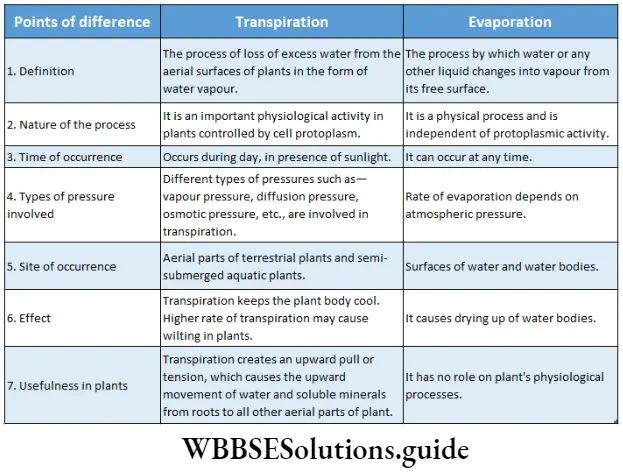
Experiment To Determine The Rate Of Transpiration
The rate of transpiration can be determined by the following experiment.
The Rate Of Transpiration Materials required: 100 ml conical flask, mustard oil or some other non-volatile oil, fresh leaf with a long stalk, simple beam balance, and water.
importance of transpiration
The Rate Of Transpiration Procedure and observation:
- 100 ml water is taken in a conical flask.
- A leaf with a long stalk is taken. Its stalk is kept immersed in the conical flask.
- A few drops of oil are added to the water in the conical flask. The oil layer will prevent the evaporation of water from the exposed surface.
- The total arrangement is weighed by a simple balance. The finding is noted.
- The arrangement is now kept in sunlight for one hour. After one hour, it is observed that the level of water has fallen.
- The weight of the whole arrangement is measured. the finding is noted again.
” importance of transpiration in plants”
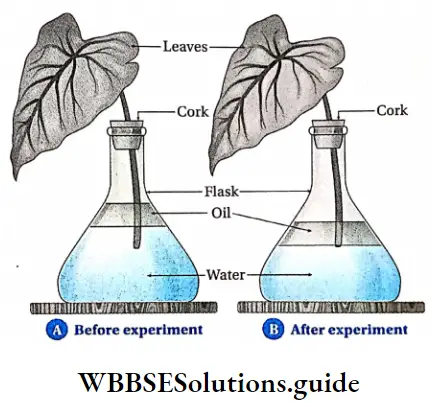
The Rate Of Transpiration Calculation: Let us assume, the weight of the setup with water, before starting the experiment = W1g
After one hour, the weight of the conical flask = W2g
Then, within one hour, the amount of water transpired = (W1 – W2) g.
” factors affecting rate of transpiration in plants”
The surface area of the leaf = X cm2
Therefore,
The rate of transpiration (g/cm2) is = (W1 – W2 / X) g/h.
Ganong’s Photometer
A potometer (Greek: poto= drunken, metra= measure) is a device used for measuring the rate of water loss by a leafy shoot through transpiration. It is also called transpirometer. The photometer designed by Ganong is known as Ganong’s photometer.
Ganong’s Photometer Structure: It is a twice-bent glass tube that has a wide-mouthed glass cylinder attached at one end. The horizontal portion of the tube has a capillary tube inserted inside and a small glass reservoir containing water is attached to it. The reservoir has a stopcock to regulate the flow of water from it.
“translocation of minerals through xylem and phloem”
The horizontal glass tube has a scale fitted to it. The wide-mouthed cylinder is fitted with a rubber cork bearing a hole. A plant, with its roots intact, is inserted through this hole.
The free end is kept inside a beaker containing colored (eosin) water. The whole apparatus is kept horizontal to the surface with the help of a stand.
“factors that affect the rate of transpiration “
Ganong’s Photometer Use: This apparatus is used to calculate the transpiration rate of the plant. Before the experiment, an air bubble was inserted in the capillary tube and it was steadied at zero reading of the scale. As water is transpired from the aerial part of the shoot a transpiration pull is created.
This will cause the absorption of water by the immersed part of the shoot. This will cause the movement of the air bubble inside the capillary tube. After a certain time, the distance covered by the bubble will be measured.
The transpiration rate will be calculated from the product of this distance and the area of the horizontal capillary tube. This rate is expressed in cm3/h.
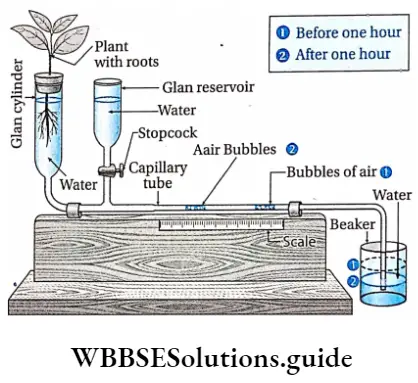

Role Ofstomata In Transpiration
About 50-97% of total transpiration takes place through stomata. So, it is important to understand the structure, function, and method of opening and closing of stomata.
- Stomata are present on the lower surface of dorsiventral leaves of dicot plants. However, stomata are present on both the upper and lower surfaces of isobilateral leaves of monocot plants.
- In phanerogams, stomata are also present in other green parts such as the stem, calyx, green pericarp, etc.
- Generally, stomata are present on the same plane as the epidermis. But, in some plants, they are present below the plane of the epidermis. These stomata are called sunken stomata. The transpiration rate decreases due to such placement of stomata. Examples of such plants include Cycas sp., Nerium sp., Opuntia sp., and other xerophytes.
- In some plants, stomata are present above the plane of the epidermis. These stomata are called raised stomata. Raised stomata are found in cucumber, pumpkin, etc.
- Stomata are absent in submerged plants, like Potamogeton, and Vallisneria.
Structure of stomata
- Stoma (plural: stomata) consists of a pore and two surrounding guard cells. This unit is also known as the stomatal apparatus. This apparatus helps in the exchange of gases and transpiration.
- In dicots, stomata are surrounded by two semilunar or kidney-shaped cells which are called guard cells. The concave sides of both the guard cells are attached to each other leaving a slit-like opening between them. This opening is called the stomatal aperture. In monocots (for example, grass, paddy, etc.)the guard cells are dumbbell shaped.
- The guard cells are living. Each cell consists of a granular cytoplasm, a distinct nucleus, a few chloroplast, starch granules, etc., which remain suspended in the cytoplasm.
- The epidermal cells associated with stomata are different from other epidermal cells. So, these cells are called subsidiary or accessory cells. These cells surround the guard cells. They do not contain any chloroplast. These cells exist as primordial utricles (cells contain a large central vacuole and the nucleus is pushed towards the plasma membrane).
- Differential thickening can be observed on the wall of the guard cells. In dicot plants, the concave inner side is thicker and rigid, whereas, the convex outer side is thinner and elastic. Thickening of the ventral side is due to the deposition of cutin and thus becomes rigid.
- In the dumbbell-shaped guard cells of monocot plants, the bulbous ends are thin-walled. The ‘handles’ have thick walls on the pore side.
- The opening of guard cells is controlled by cellulose microfibrils present in guard-cell walls. These are oriented around the circumference of the elongated guard cells. They radiate from the center of the stoma. This microfibrillar arrangement is called radial micellization.
When the guard cells absorb water, this microfibrillar arrangement helps in their outward expansion of them. This results in a tension in the pore region. The two guard cells are attached to each other at both ends. This tension, force results in the outward bending of the inner walls of the guard cells and thus stomatal pore opens. - Each stoma is associated with an interior respiratory cavity air cavity or sub-stomatal chamber. This chamber opens up to the atmosphere through the stoma.
Function of Stomata
Stomata take part in several physiological functions for the plant.
Stomata Exchange of gases: Through the open stomata, CO2 is taken in and O2 is released during photosynthesis. The gaseous exchange occurs between the plant body and the atmosphere, by diffusion.
“importance of mineral translocation in plant growth”
Stomata Transpiration: Stomata release excess water into the atmosphere from mesophyll cells of leaves, by transpiration.
Stomata Synthesis of organic substances and their storage: Guard cells have chloroplasts in them and are able to photosynthesize. This results in the synthesis of glucose which is temporarily stored in the form of starch.
Opening and closing of stomata occurs due to turgor changes in guard cells. The roles of guard cells, light, K+, and microfibrils in the opening and closing of stomata are given below.
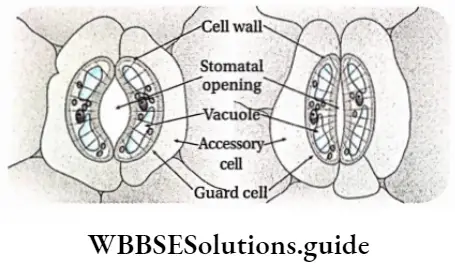
Stomata Role of guard cells: the process of transpiration is dependent on the opening and closing of stomata. generally, in the presence of sunlight, stomata remain open. so, transpiration occurs during the day through the stomata.
On the other hand, stomatal opening and closing also depend on the increase or decrease in the turgor pressure of the guard cells. during the day, starch stored in guard cells breaks down into glucose.
This causes the entry of water into guard cells from accessory cells. thus, turgor pressure in guard cells increases. As a result, guard cells swell up and the stoma opens.
During the night the guard cells become flaccid due to the release of water from the guard cells to the accessory cells and the presence of high starch concentration. As a result, the stomata close. the turgor pressure of guard cells decreases further at the time of stomatal closing.
Stomata Role of light: Plants respond to light by opening stomata for CO2 uptake. Upon darkness, stomata gradually close to prevent loss of water in the absence of light. However, if plants experience water deficiency due to low humidity, low soil moisture, or other conditions, stomata remain closed even during the daytime.
Types Of Stomatal Movement
Photoactive movement: In this case, the movement of stomata is controlled directly or indirectly by light. Stomata that show photoactive movement, remain open at the day and close at night. example mango, pea, and pumpkin plants.
Scotoactive movement: The Latin word scoto means ‘darkness’. In this case, stomata remain open at night and close at the day. This type of stomatal movement is observed in cactus-like xerophytic plants.
Role of K+: The Opening and closing of the stomata aperture is regulated by K+ concentrations in the guard cells. As per modern concepts, in the presence of sunlight, stored starch in guard cells, is converted into malic acid.
This malic acid dissociates into H+ and malate ion R(COO–). H+ is released from guard cells and in turn, K+ and water from accessory cells enter the guard cells. This causes an increase in the turgidity of guard cells and as a result, stomata open.
Role of microfibrils: The radial arrangement of microfibrils, i.e., radial micellation of guard cells aids in opening and closing of stomata. When water enters guard cells, microfibrils increase in length but not in diameter. As a result, the outer walls of both the guard cells move away from each other.
The ends of guard cells are attached, so they extend outward due to swelling up. This causes stomata to open like the shape of a biconvex lens.
Theories related to the opening and closing of stomata
Different theories have been given by scientists to explain the phenomena of opening and closing of stomata.
Starch sugar hypothesis: This hypothesis was proposed by Sayre (1926) and later it was modified by Steward (1964). So this hypothesis is also known as Steward’s hydrolysis of starch.
In the presence of light: According to this theory opening and closing of stomata in the presence of light involves the following events—
1. The CO2 stored in the mesophyll cells of leaves is used up during photosynthesis. This causes a decrease in H+ ion concentration in guard cells. As a result, pH increases to 7.0.
2. At pH 7.0, the activity of the enzyme phosphorylase increases. It CQnverts starch into glucose-l-phosphate, in the presence of phosphoric acid.
image
3. The enzyme phosphoglucomutase converts glucose-l-phosphate to glucose-6-phosphate.
⇒ \(\text { Glucose-1-PO } \mathrm{PO}_4 \stackrel{\text { Phosphoglucomutase }}\text { Glucose-6- } \mathrm{PO}_4\)
“process of translocation of minerals with diagram”
4. Glucose-6-phosphate breaks down into glucose and inorganic phosphate by the action of enzyme phosphatase.
⇒ \(\text { Glucose-6- } \mathrm{PO}_4 \stackrel{\text { Phosphatase }}{\longrightarrow} \text { Glucose }+\mathrm{Pi}\)
5. Glucose and inorganic phosphate dissolve in cell sap and thus, increase its concentration. This causes an increase in osmotic pressure in guard cells and a decrease in water potential. As a result, water from accessory cells enters the guard cell and the stomata opens.
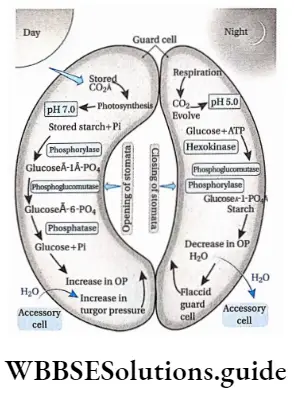
In the absence of light: According to this theory opening and closing of stomata in the absence of light involves the following events—
1. During the night, photosynthesis does not occur, only respiration takes place. This causes an increase in C02 concentration in the sub-stomatal cavity. This leads to a decrease in pH (pH=5.0).
2. At pH 5.0, phosphorylase becomes inactive. Glucose molecules in guard cells, in the presence of ATP, form glucose-6-phosphate and ADP. This reaction is mediated by the enzyme hexokinase.
⇒ \(\text { Glucose }+ \text { ATP } \stackrel{\text { Hexokinase }}{\longrightarrow} \text { Glucose- } 6-\mathrm{PO}_4+\text { ADP }\)
3. Glucose-6-phosphate is converted to glucose-phosphate by the enzyme phosphoglucomutase.
⇒ \(\text { Glucose-6- } \mathrm{PO}_4 \stackrel{\text { Phosphoglucomutase }}{\rightleftharpoons} \text { Glucose-1-PO }\)
4. Glucose-1-phosphate molecules form a chemical bond with each other by the action of the enzyme phosphorylase, to form starch.
⇒ \(\text { Glucose-1-PO }{ }_4 \stackrel{\text { Phosphorylase }}{\longrightarrow} \text { Starch }+\mathrm{Pi}\)
5. When starch forms in guard cells, it increases water potential and decreases osmotic pressure. Then water from guard cells is released into accessory cells. As a result, guard cells become flaccid, and stomata close.
Criticism: The reasons behind the criticism of Steward’s hydrolysis of starch are as follows—
- Interconversion of starch and glucose is a slow process. So, this mechanism cannot explain the rapid opening and closing of stomata.
- Stomata opens more in blue light than in red light. This phenomenon cannot be explained by this hypothesis.
- Opening and closing of stomata may occur in the absence of stored starch in guard cells. For example, starch is absent in the guard cells of the leaves of monocot plants.
- Stomatal opening and closing are also affected by light and temperature.
Active potassium theory: This theory was propounded by Levitt (1974). It was supported by Raschke (1975), Bowling (1976), Noggle and Fritz (1976).
In the presence of light: According to this theory opening and closing of stomata in the presence of light involves the following events—
1. In the presence of sunlight, cells use up CO2 for photosynthesis. This results in a decline in CO2 concentration in a sub-stomatal cavity and the pH is increased (pH=7.0). At higher pH, starch in guard cells is converted into glucose 6-phosphate. 6-phosphate through glycolysis gives rise to phosphoenolpyruvic acid. The rate of this reaction accelerates under blue light (430-460nm).

2. CO2 reacts with phosphoenolpyruvic acid to form oxaloacetic acid. This reaction is carried out by the enzyme phosphoenolpyruvic carboxylase.

3. Oxaloacetic acid is converted into malic acid, by the enzyme malate dehydrogenase.
⇒ \(\text { Oxaloacetic acid } \stackrel{\text { Malate dehydrogenase }}{\longrightarrow} \text { Malic acid }\)
4. Malic acid in guard cells dissociates into malate ions and H+ ions.

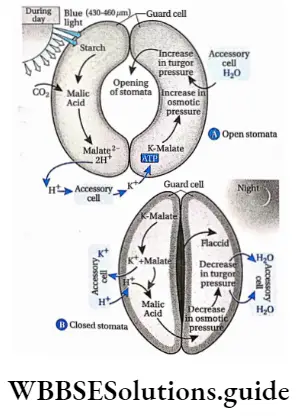
5. H+ from guard cells moves into accessory cells. In turn, K+ ions enter guard cells from accessory cells, thereby causing ion exchange. Hence, this is an active process or ATP-requiring process.
6. Some Cl– ions are also taken into maintaining electrical and ionic balance.
7. K+ ions react with malate ions and form potassium malate. This causes an increase in osmotic pressure and a decrease in water potential in guard cells. So, the water enters accessory cells to guard cells by endosmosis and makes them turgid. This results in stomatal opening.
In the absence of light: According to this theory opening and closing of stomata in the absence of light involves the following events—
- At night, photosynthesis does not occur. However, respiration occurs. So, CO2 concentration in the substomatal cavity increases and the pH value decreases (pH 5.0).
- Increased CO2 concentration inhibits proton movement through the cell membrane. This causes an efflux of K+ ions along the gradient from guard cells to accessory cells.
- CT ions also get transported from guard cells to accessory cells.
- Lack of K+ ions causes malate ions to react with H+ ions to form malic acid.
- As K+ ions move to accessory cells, the osmotic pressure of guard cells decreases, and water potential increases. Thus, water flows from guard cells into accessory cells. Thus, guard cells become flaccid and stomata close.
Effect of abscisic acid and blue light on stomata
Stomatal opening depends on the concentration of K+ ions in cells. Increased K+ concentration makes the water potential of guard cells more negative and so, water enters by osmosis.
Abscisic acid (a plant hormone) can invoke stomatal closure under water deficit conditions. When water content in plants is low, pH decreases in guard cells. ABA gets activated at low pH. ABA alters the permeability of the cell membrane and prevents the transport of K+ ions inside the guard cells.
Blue light is known to enhance stomatal opening by activating a proton pump (flow of proton (H+) along a gradient) in the guard cells. The proton gradient drives the accumulation of K+ inside the cells.
In cactus-like plants, stomata remain closed during the day but open at night. In these plants, transpiration occurs at night. Hence, their stomata are photoactive. This type of stomatal movement is explained below.
In the absence of sunlight: In these plants, the pH of guard cells increases due to the higher concentration of CO2 generated by cellular respiration. PEP carboxylase converts phosphoenolpyruvate into oxaloacetate (OAA), in the presence of CO2. OAA is reduced to malic acid by the enzyme dehydrogenase.
Malic acid breaks down into malate ions and H+ ions. K+ ion enters guard cells in exchange of H+ ion. K+ ion and malate ion react to form potassium malate, which increases osmotic potential in guard cells.
This causes an influx of water from accessory cells to guard cells which makes the cells turgid and stomata open. In the presence of light: In the presence of light, stored acid (malic acid) in plants breaks down to release CO2.
This carbon dioxide is used up to produce glucose through the Calvin cycle. Efflux of K+ ions occurs from guard cells to accessory cells. This causes an increase in the water potential of guard cells and an efflux of water from guard cells to accessory cells. As a result, guard cells become flaccid and stomata closes.
Factors Affecting The Rate Of Transpiration
The transpiration rate is influenced by a number of internal factors and external factors.
External factors or Environmental factors
The most important external factors influencing transpiration rate are discussed below.
The concentration of CO2 in the atmosphere: It has been observed that when the concentration of CO2 in air exceeds 0.03%, then stomata close down, and the rate of transpiration is reduced. Experimentally it has been observed that in the absence of CO2, stomata remain open even at night.
Relative humidity of air: If relative humidity increases, then the rate of transpiration decreases.
Light: The rate of transpiration is higher in the presence of light. This is because stomata remain open in the presence of light. As the intensity of sunlight increases, the temperature of the leaf surface also increases.
This causes more stomata to open. Thus the rate of transpiration increases. But in intense sunlight, stomata close down, causing cessation of transpiration.
Temperature: An increase in temperature brings about an increase in the rate of transpiration. The maximum rate of transpiration is observed within 10-25°C. Below 10°C and above 25’C, stomata are close to causing cessation of transpiration.
“active and passive transport in mineral translocation”
Wind Velocity: Water vapor released through transpiration saturates the air in the vicinity of the leaf. Relatively low wind velocity increases the rate of transpiration because it does not let the water vapor to accumulate near the leaf.
However, the wind of higher velocity results in a reduction in transpiration. This happens by the combined influence of cooling of the surrounding environment and stomatal closure. During heavy storms,’ the stomata of leaves close, which prevents transpiration of water.
Soil Condition: The availability of soil water has a great influence on the rate of transpiration. If the amount of soil water is reduced, the absorption rate of water is also reduced. Reduced water content in leaves causes closure of stomata and thus the rate of transpiration falls. A high concentration of soil solutes decreases the rate of water absorption as well as the rate of transpiration.
Internal factors affecting transpiration are given below.
Leaf Structure: The general structure of the leaf has an influence on the process of transpiration. The rate of transpiration is affected by different features of the leaf.
These are
- Presence of thick cuticle and/or epidermal hair on the surface,
- The presence of waxy coating or suberin on the epidermis,
- reduced number of stomata,
- Presence of sunken stomata, etc.,
- Leaves of many plants get modified to thorns, spines, scaly leaves, etc., to reduce transpiration.
Root-Shoot Ratio: One of the most important internal factors is the root-shoot ratio. The greater the root-shoot ratio, the greater the rate of transpiration.
Plant hormone: Phytohormone cytokinin, induces opening of stomata and thus increases the rate of transpiration. Another phytohormone abscisic acid shows the opposite effect.
Stomatal Frequency: Stomatal frequency means the total number of stomata per unit area of the leaf. The frequency varies with the species and their habitat. Therefore, transpiration varies in different plant species.
Scientist Salisbury introduced the term ‘stomatal index’ to relate this stomatal frequency with the rate of transpiration. The stomatal index can be calculated by the following formula— I = S/E+S
where, l=stomatal index, S=total number of stomata per unit surface area of leaf, and E=total number of epidermal cells per unit surface area of the same.
The rate of transpiration increases with the increase of the stomatal index.
Significance Of Transpiration
Transpiration is both necessary as well as harmful in plant life. While transpiration helps in the absorption of water by the roots, at the same time it causes water loss from the leaf surface. For this reason, transpiration is often regarded as a ‘necessary evil’. The advantages and disadvantages of this process are given below.
Advantages of transpiration
There are many advantages of transpiration occurring in a plant.
Ascent of sap: Transpiration produces diffusion pressure deficit in mesophyll cells of the leaf. This produces a suction force which is known as transpiration pull. Due to this pull, water and dissolved minerals (xylem sap) from roots rise up through the xylem vessel by forming a continuous water column. They are then distributed throughout the plant body.
Cooling Effect: Generally it is said that light rays absorbed by 1 cm3 leaf surface, raise the temperature by 37°C per minute. So, in a few minutes it may attain a thermal death point, i.e., 50-60°C, which is fatal for protoplasm.
However, this does not happen, because, of transpiration. During the day, the latent heat absorbed from the plant body converts water into vapor. This water vapor is released by transpiration. Thus, transpiration prevents the plants from overheating by utilizing heat indirectly.
Effect on Water Movement: The absorbed water is translocated from roots to leaves which is greatly influenced by transpiration pull. It has been observed that only 1-3% of the absorbed water is utilized by the plants for different physiological and metabolic activities. So, the excess water has to be removed from the plant body. By stomatal, lenticular or cuticular transpiration, this excess water is released in the atmosphere.
Optimum Turgidity: Transpiration maintains an optimum cell turgidity in terrestrial plants. There is an optimum level of turgidity, below and above which plant cells do not function efficiently.
Maintenance of this optimum turgidity enables a plant cell to carry out many functions, such as opening and closing of stomata, cell division in meristematic tissue, flowering, helping soft plant parts to stand upright, different types of nastic movement, etc.
Role in Precipitation: Water vapor content in the atmosphere increases due to transpiration. This causes rainfall. Therefore, transpiration has an important role in precipitation.
Disadvantages of transpiration
Water is essential for physiological functions in living organisms, so the removal of excess water by transpiration is also harmful for plants. The disadvantages of this process are given below.
Wilting: During summer, the rate of transpiration becomes highest at noon. As a result, the rate of transpiration exceeds the rate of water absorption. This leads to a shortage of water in the cells and it makes them flaccid. Due to this reason, leaves droop. This phenomenon is known as wilting.
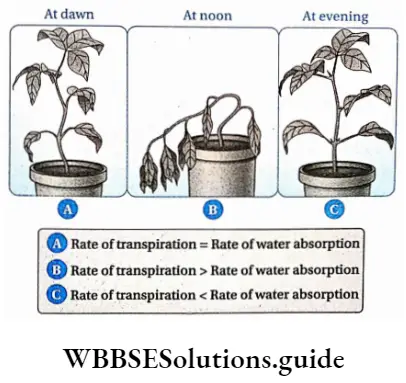
Transpiration and photosynthesis—a compromise
Photosynthesis is a delicate process. Through transpiration, all factors (water, minerals, cooler temperature, and turgid cell) necessary for photosynthesis, are made available to the plant.
Excessive transpiration causes loss of water and reduces the rate of photosynthesis. But without transpiration, no transpiration pull will be created and water will not reach the leaves. Hence, transpiration is a compromise for the plant to make photosynthesis happen without disruption.
The evolution of the C4 photosynthetic system is probably one of the strategies for minimizing water loss without disrupting the availability of CO2. A C4 plant fixes twice the amount of carbon but loses only half the amount of water than a C3 plant. In CAM plants, the demand for water is the least as their stomata remain closed during the daytime.
Antitranspirants
Definition: The chemicals which are applied (sprayed) to the aerial parts of plants in order to reduce the rate of transpiration, without affecting its normal growth and metabolism are called antitranspirants.
Types of antitranspirants: They may be of two types—
Metabolic antitranspirants: These antitranspirants reduce the opening of stomata. example phenylmercuric acetate (PMA), abscisic acid (ABA), and aspirin.
CO2 as the natural antitranspirant
If the concentration of atmospheric CO2 is increased from 0.03% to 0.05%, partial closure of stomata has been observed. If the concentration of CO2 is increased further, then, complete closure of stomata has been observed. As a result, photosynthesis is also hampered.
Film-forming antitranspirants:
These antitranspirants when sprayed on leaves, form a colourless, transparent layer on leaf surfaces. This layer is permeable to 02 and C02 but not to water vapor. example silicon emulsion, low viscosity waxes, etc.
Importance Of Using Antitranspirants:
Transpiration involves the loss of water from plants through leaves. To make up for this loss, water is taken up from the soil by roots. This in turn causes a loss in soil water.
Also, the loss of water from a plant body affects some of its physiological and metabolic functions like photosynthesis, respiration, nutrition, growth, etc. Antitranspirants are therefore useful for reducing the loss of water from the plant body and hence from the soil.
Uptake Of Mineral Ions And Their Translocation
Plants absorb minerals from soil and translocate those to other parts of the body. The organic food is translocated from leaves to all the cells of the plant body by phloem.
Uptake Of Mineral Ions
The elements that are necessary for normal growth and development of plants are known as essential elements. In the soil, these minerals are present in ionic form. The essential ions are absorbed by the root hairs in different quantities and then translocated through the xylem stream to the different parts of the plant body. Previously, it was thought that inorganic salts were passively absorbed along with water.
But at present it is considered that mineral ions are absorbed at the expense of energy as the water potential of the soil water is greater than that in root hair. Different theories have been proposed by different scientists to explain the mechanism of ion absorption.
There are two major mechanisms for ion uptake —
- Non-Mediated Uptake And
- Mediated uptake
Non-mediated uptake
The driving force behind this kind of uptake is its chemical potential gradient. The mechanism is also described as passive ion uptake. Passive non-mediated absorption includes different types of mechanisms like diffusion, ion exchange, Donnan equilibrium, mass flow, etc.
Diffusion: When a plant cell or tissue is transferred from a medium of lower salt concentration to a medium of relatively higher salt concentration, there will be an initial uptake of ions due to diffusion. This mechanism is temperature-independent and remains unaffected by the application of metabolic inhibitors.
Ion Exchange: In this mechanism, the ions within j the cells are exchanged for the ions of equivalent charge | of the external solution. A solution of a dissociable salt (A+ and B–) can be separated from distilled water by a membrane that is permeable to both ions.
Then diffusion will occur until the concentration of ions on both sides becomes equal. Let us assume, two solutions containing different salts (A1B1and A2B2) are separated from one another by a semipermeable membrane j (cation-permeable/anion-impermeable or cation- J impermeable/anion-permeable membrane).
The solutions will contain 4 different types of ions (A1+ and B1–; A2+ and B2–). One of the two ions in each case, is free to move across in exchange for an ion of the same charge.
This movement will occur until the concentration of ions becomes equal on both sides. Hence, at equilibrium, [A1+]/[A2+] (when cation is permeable) and [B1–/B2–] (when anion is permeable) are equal on both sides.
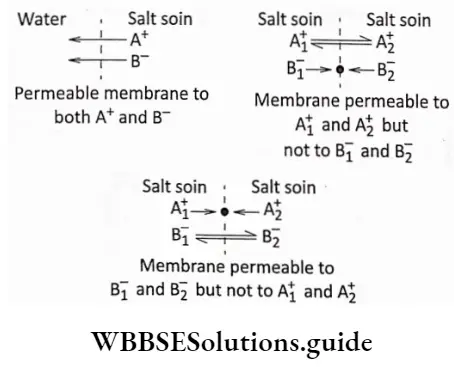
The total concentration of salts on either side is not affected by the exchange of ions. Exchange involves; equivalent electrical charge, so that two univalent ions are exchanged for one bivalent, three for one trivalent ion, and so on.
Donnan Equilibrium: This theory accounts for the effect of non-diffusible ions on ion uptake. This theory also explains the cooperation of both electrical as well as diffusion phenomena. It is a complex ion exchange system in which the membrane is impermeable to certain ions called fixed ions.
The fixed ions cannot pass through the membrane. In both the figures be|ow, x+ and Y– are fixed ions and cannot move through the membrane. Instead, some other ions get absorbed against the concentration gradient.
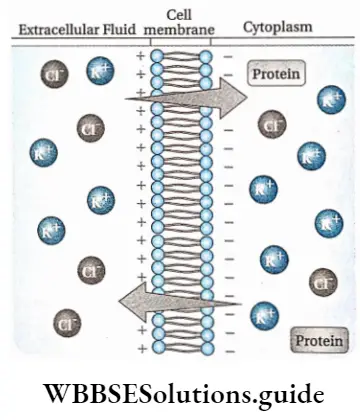
In the first case where K+ is fixed, an equal number of cations and anions from the left side will diffuse across the membrane. The movement of ions continues till the equilibrium is reached. However, additional anions are required to balance the positive charges of the fixed locations on the right side of the membrane.
“role of root pressure and transpiration in mineral translocation”
Therefore the anion concentration would become greater on the right side than it is on the left side. Similarly, in the second case where Cl– is fixed, cation accumulation takes place at the equilibrium. Thus, the accumulation of ions against a concentration gradient can occur without using any metabolic energy. This process continues until the Donnan equilibrium is reached.
Mass Flow of Ions: Many scientists believe that ions are absorbed by roots along with the mass flow of water influenced by transpiration pull. The mechanism states that a higher transpiration rate causes more absorption of ions.
Some scientists obtained a correlation between the rate of water transport and the uptake of nutrients. However, when the inhibitors of respiration were added to the system, this correlation usually got affected.
Mediated uptake
Mediated uptake takes place in the presence of carrier proteins in the membrane. These carrier proteins interact with the ions or molecules. Ions form a complex with the carrier protein on the outer side of the membrane. After crossing the membrane, this complex is broken down to release the transported ion and the carrier protein.
There are different carriers for different cations and anions. They are also called transporters or permeases. These carriers may be of different types such as:
- Uniport,
- Symport and
- Antiport.
These transporters have been discussed previously in this chapter.
Mediated transport is classified into two categories depending on the thermodynamics of the system—
- Facilitated diffusion (also called passive uptake or transport), in which a specific molecule flows from a region of high concentration to a low concentration,
without the expenditure of energy. - Active uptake or transport, in which a specific molecule is transported from a region of low concentration to high concentration, against its concentration gradient.
Facilitated Diffusion: Facilitated diffusion has been explained earlier in this chapter. Facilitated diffusion of ions occurs by ionophores.
“factors affecting translocation of minerals in plants”
Ionophores are organic molecules that help in the transport of mineral ions across the cell membrane.
There are two fundamental classes of ionophores—
- Carrier ionophore,
- Channel-forming ionophore.
Carrier Ionophore: Carrier ionophores increase the permeability of membranes to a particular ion by binding the ion, diffusing it through the membrane, and releasing it on the other side. After releasing the ion, the ionophore must then return to the other side of the membrane, to repeat the process.
The ionic complexes of all carriers must therefore be soluble in membrane lipids. The carrier ionophores are specific in nature. They can transport larger or charged molecules. Carriers do not catalyze ATP hydrolysis.
They do not involve chemical modification of any of the compounds bound to the carrier. The principal inorganic nutrients, including NH4+, NO3–, Pi, K+, Cl-, and SO42- are all translocated into cells by plasma membrane carriers.
Channel-forming ionophore: A second type of ionophore is channel-forming ionophore. It forms a transmembrane channel or pore through which the selected ions can diffuse. Even a small amount of ionophore greatly increases the permeability of a membrane toward a specific ion.
For example, a single molecule of carrier antibiotic valinomycin transports up to 104 K+ per second across a membrane. Channel-forming ionophores, such as the antibiotic gramicidin A, have an even greater ion output (over 107 K+ ions per second).
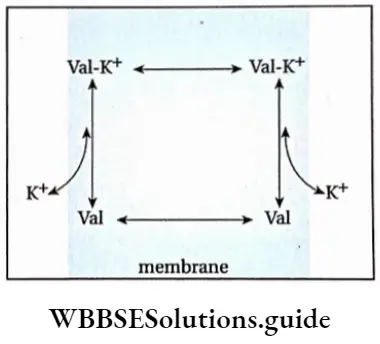
Ion channels are driven solely by electrochemical potential differences. Ion flow through channels is passive. The ion channels are specific to ions.
Ion channels in plants are categorized into two types—
- Cation channels and
- Anion channels.
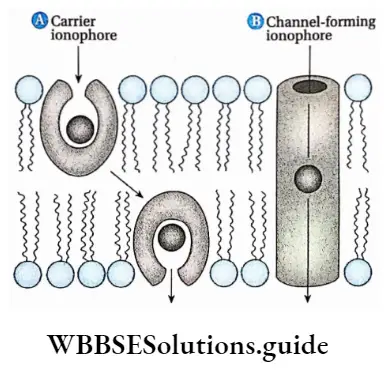
Criticism related to facilitated diffusion concept: The following facts are against the passive ion transport concept—
- Generally, absorption of ions or minerals occurs at a faster rate which cannot be explained by passive absorption.
- Passive absorption theories cannot explain the absorption of ions or minerals against the osmotic gradient. Some plants (Chara australis, Nitella translucent) can absorb 1000 times more K+ which is not in accordance to their environment.
- It has been experimentally found that the absorption of minerals is related to the metabolic activities of the plant.
Active uptake: Active uptake of ions is one of the most important features of life processes. The transfer of ions occurs at the expense of the free energy liberated by the hydrolysis of ATP.
Both anions and cations are accumulated within plants, to a great extent, against a concentration gradient. It has also been observed that the rate and amount of absorption of ions are directly related to the expenditure of metabolic energy.
The freshwater green alga Nitella can absorb potassium ions (K+) to a concentration 1000 times more than the concentration of K+ ions in the surrounding medium. This type of absorption where the concentration of ions is much higher within the cells than in the external solution is called ion accumulation.
It has been proved that free diffusion and other passive mechanisms do not involve the expenditure of metabolic energy. So, the mechanisms are not effective for such a great accumulation of these ions.
“short notes on translocation of minerals for NEET”
The active uptake of salt in ionic form may be of two types—
- Primary or
- Secondary.
Primary active uptake: The primary active uptake is coupled directly to an energy source. These energy sources are—ATP hydrolysis, an oxidation-reduction reaction, etc.
The membrane proteins that carry out this process are called pumps. Most pumps transport ions. Ion pumps are further characterized as either electrogenic (involving net movement of charge) or electroneutral (no net movement of charge).
For example, the Na+/K+- ATPase pump of animal cells is an electrogenic pump. It pumps three Na+ ions out for the inward of two K+ ions. This results in a net outward movement of one positive charge.
Secondary active uptake: Secondary active uptake uses the energy stored in an electrochemical-potential gradient. Protons are extruded from the cytosol by electrogenic pumps.
These pumps operate in the plasma membrane and tonoplast. Consequently, a membrane potential and a pH gradient are created at the expense of ATP hydrolysis. This gradient of electrochemical potential for H+ ions generates the proton motive force.
Minerals such as Fe, Ca, Cu, Mn, Zn, etc., are essential for normal growth and development of plants. They can be toxic when present in excess. Thus, membrane transport systems are likely to play a central role in these processes.
This system is regulated by a wide range of genes. The application of genetic and molecular techniques has led to the identification of such genes.
Many studies indicate that solute transport into cells is strongly dependent upon metabolic energy. Ion accumulation is inhibited when the metabolic activity of the plant is inhibited by —
- Low temperature
- Low oxygen concentration
- Metabolic inhibitors and so on.
“translocation of minerals PDF notes download”
Salt accumulation and respiration are parallelly affected by oxygen tension. With the decrease in oxygen content of the medium, ion accumulation decreases and ultimately stops completely. Metabolic inhibitors like azides and cyanides inhibit ion accumulation along with the inhibition of respiration.
The rate of respiration increases when a plant or tissue is transferred from water to a salt solution. When an extra amount of salt is added, the rate of respiration is increased over the normal rate which is called salt respiration or anion respiration. This phenomenon is additional evidence in support of the active process of ion uptake.
